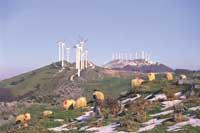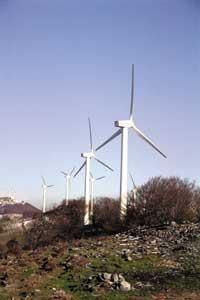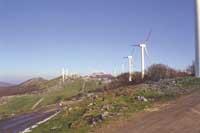Wind energy

How to put the wind at the service of man
The wind is due to the warming of the earth's surface by the Sun. Hot air tends to ascend, occupying its place the cold air coming from the high layers of the atmosphere, forming the air currents that form the wind. These air currents are a form of kinetic energy that is formed in nature (solar energy is transformed into kinetic energy) and that human beings have used and learned to take advantage of it since time immemorial, such as sailboats and windmills.
It is estimated that the solar energy that is transformed globally into wind energy is sufficient to produce 10x106 kilowatts per hour, exceeding the global demand for electric power.
Wind power has great advantages: it is free, clean and renewable and, since the wind is everywhere, it can be said that it is a source of great extension. Other characteristics that can be considered negative are non-continuity (not always the wind flows) and the difficulty of accumulation. In order to take advantage of the wind energy, two aspects must be taken into account: the wind speed and the type of machine chosen for its use.
Currently, there are two trends in the use of wind energy: the exploitation by low power generators (150 kW) and the exploitation by medium and high power generators. The former are used in isolated places, accompanied by other energy sources and the latter are connected to the grid. The latter require geographical locations of great wind potential.
Wind engines
Throughout history, in general, there have been three main types of wind machines: on the one hand, the traditional mill, on the other, the multi-arm mill, mainly used to pump water, and finally, the two or three arms aerodynamic helix generators.
Basically, all wind machines can be grouped into two large groups depending on their operation. In a group the rotor blades turn by the direct thrust of the wind. According to this principle, the end of the slope farthest from the axis will hardly exceed the wind speed. And if the wind pushes one thing, it cannot catch more speed than the wind. Therefore, the axis of the machine rotates at a relatively low speed and since the electric generators used today require a high rotor speed, it is necessary to multiply the rotation speed of the axis of the blades over and over again to achieve suitable turning speeds on the generator axis.
This means a loss of performance and a major system complication. However, these machines usually have a large surface facing the wind, so it is enough that the slightest movement of the wind begins to turn the arms. In addition, these machines have a very large time, that is, a great force and are ideal for performing mechanical work such as water pumping, grain crushing, air compression, etc. Within this group are the traditional mills, multi-arms, and the Savonius rotor, vertical axis, among others. All are simple and inefficient.

The principle of operation of the second group is the same as that of birds and planes to fly, that is, to keep them. Due to the special section of the blades of the aerodynamic propellers, normally with smooth and convex profiles, the air reaches different speeds when passing through one and the other side of the arm. This causes a pressure difference between the two sides of the arm. The air passes faster through the convex part than the flat part, generating depression, absorption and generating sustaining force, which is what turns the arms around the axis.
In addition, as the containment coefficient increases with wind speed, the generator arm can exceed wind speed, allowing direct connection of the electric generator to the shaft. Therefore, it is a more effective system than the previous one. The disadvantage of these machines is that they are of small pair of starts, that is, slow to start moving. The main advantage is efficiency, as they obtain between two and three times more mechanical energy than a multi-arm of the same diameter. Among the generators that take advantage of the containment phenomenon are those of double arm, three arms and the generators of the vertical axis called Darrieus. The first two, horizontal axis, are the most extended. Adding more blades or arms has almost no advantage and increases costs.
Auxiliary elements of wind farms
Wind systems require additional mechanisms for their proper functioning. Some, such as electrochemical accumulators and electrical production control systems, are the same as those used in solar photovoltaic installations, while others are specific to wind systems. These include orientation systems that ensure that the propeller is always wind-oriented. The control systems protect the machine from strong winds.
The one that transforms wind energy into electric energy can be a dynamo or an alternator. The dynamos produce direct current. They are necessary when using electric accumulators, but the performance is not as good as that of alternators. Alternators generate alternating current that can be used directly or sent to electric accumulators by rectifying.
Speed multiplication systems are also necessary to achieve maximum efficiency of the wind turbine. For this, gearboxes, belts, chains, etc. are used.
Advantages of wind energy
Today it is assumed that we should not be afraid of the depletion of fossil energy sources, but of the consequences they generate. Oil and coal, before being exhausted, will produce a huge global impact, so the need to change the use of these energy sources is very serious. From this point of view, the need for a strong boost of wind energy is evident. A 1 MW wind farm in an appropriate location saves the following emissions for one year: 3,900 tons of CO2, 75 tons of SO2 and 11.5 tons of NOX, as well as a possible earthmoving of up to 22,880 m3.
On the other hand, the wind industry needs more labor than other energy industries. For example, to produce 1 TWh of electric power, nuclear power needs 100 jobs, thermal 116 and wind 542. These data were provided by the World Watch Institute in 1990 and, according to experts, remain similar. In any case, it can be said that wind energy generates more jobs than any conventional energy source.
Impacts of wind energy exploitation
Despite the benefits of using wind as a source of energy, it cannot be denied that it generates environmental impact: noise and some consequences of this form of exploitation are dead birds. In addition to the problem of birds trapped on the slopes, the impact on the landscape can be the hardest of all, at least for many nature lovers and mountaineers.

As for noise, a wind turbine generates two types of noise, one mechanical and one aerodynamic. The first has been substantially reduced as the increase in machine efficiency and noise reduction are combined. The seconds are more difficult to solve than generators are based on noise-generating techniques. In general, a wind installation produces no more noise than another industry of the same power, although its location in natural environments becomes more evident. In any case, a 500 kW wind turbine located 400 meters, does not exceed the maximum level of outside noise legally allowed in a room during the night.
The main problem that wind farms have had to date has been their impact on birds. To minimize this impact, the location of the wind farm should be appropriately chosen, so that the same circumstances that occurred in the wind farm of Tarifa located in the southern end of Spain do not occur, since part of the park was located between a landfill and the nest of a colony of vultures, so that 50 birds died in the first two years. It was solved with the closure of the landfill. Statistically, every 14 years a bird per turbine dies, which is less than the mortality produced by power lines, traffic or a relatively large thermal power plant around it.
As for the landscape impact, it must be said that this is a very subjective area: some say that the windmills that line the mountains are beautiful, others do not believe that the landscape can withstand this type of stains. The three elements that generate a visual impact on wind farms are wind turbines, power lines and control buildings. To mitigate the impact, the generators are painted in low colors, buried the threads and the buildings are hidden between the elements of the orography.
,
Other impacts resulting from the exploitation of wind energy are erosion due to construction works, damage to local fauna and flora, land occupied by the park, etc. In any case, these are small and easily repairable with the appropriate measures.
Wind energy in the Basque Country
In the Autonomous Community of the Basque Country and in the Autonomous Community of Navarra, a strong commitment to wind energy has been made, especially in Navarra. In the latter territory it is intended to cover 45% of the electricity needs in 2010. The Navarra Energy Plan is expected to install 636 megawatts of power (for example, the Santa María de Garoña nuclear power plant has a power of 460 megawatts), of which 220 MW are prior to the year 2000.
Until 1997 there were three wind farms in Navarre: Erreniaga, Aritz and Gerinda, 40, 32 and 115 wind turbines, respectively. Among the three had installed a power of 108 MW. In the Autonomous Community of the Basque Country the aspirations are lower, since the territory is smaller. According to the Territorial Sector Plan of Wind Energy of the CAPV, for the year 2005 there will be 437,500 megawatts annually, for which a power of 175 megawatts will be installed.
|Power (MW)Germany2.079United States1.601Danar1-059India845Spain378Holanda318Gran Bretaña312China166Sueco1103Other




